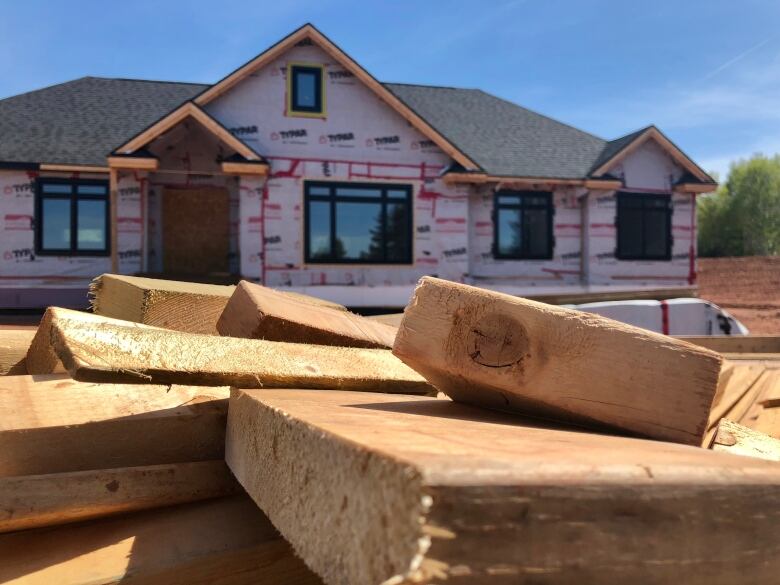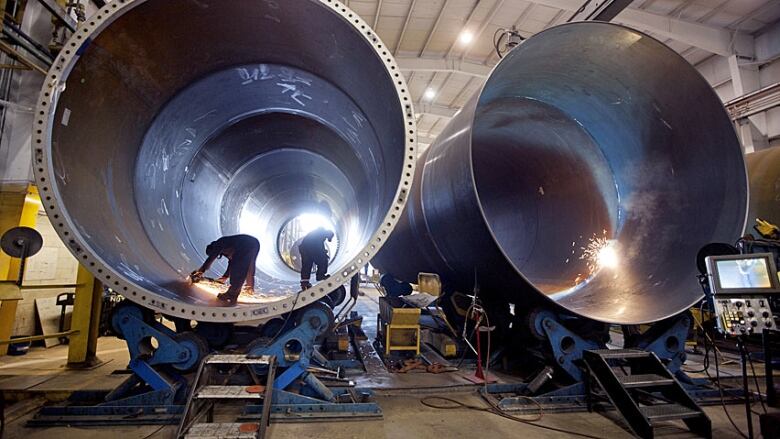Promising more fiscal restraint, Freeland tables a lower-spending budget focused on housing
The 2022-23 deficit projection is $52.8 billion half of what it was last year

Finance Minister Chrystia Freeland tabled her second federal budget Thursday a multibillion-dollar plan meant to help the country weather increasingly uncertain times through major investments to cool Canada's red-hot housing market and supercharge the transition to a cleaner, greener economy.
Freeland signalled the days of eye-popping 12-digit budget deficits are coming to an end and promised a return to greater fiscal prudence now that the immediate threat of COVID-19 has abated.
With corporate Canada jittery about Ottawa's sky-high deficit spending in recent years, Freeland acknowledged the country's ability to spend is "not infinite" and with interest rates now rising to tame inflation it's time for the government to "review and reduce" spending.
To that end, Freeland tabled a relatively thin 280-page budget 500 fewer pages than last year's document that is much more focused on a few key areas than Liberal budgets of the recent past. The budget allocates only $31.2 billion in net new spending over the next five years a fraction of the sums in recent budgets.
"Canada has a proud tradition of fiscal responsibility. It is my duty to maintain it and I will," Freeland said.
Better news on the deficit front
Canada's finances have improved in the few months since Freeland tabled her last fiscal update. With the federal government winding down costly COVID-related spending and cashing in on substantially higher oil prices, the deficit for the 2021-22 fiscal year will be $30 billion lower than what Freeland predicted it would be in December.
The 2022-23 deficit projection is $52.8 billion half of what it was last year.
"It's really not a lot of spending relative to past budgets. Actually, it's a pretty slim budget for the size of our economy," said Kevin Page, president and CEO of the Institute of Fiscal Studies and Democracy at the University of Ottawa. "It's just not a big-spending budget."
The government's preferred fiscal anchor, the debt-to-GDP ratio (which tracks the size of the federal debt compared to the economy as a whole), is expected to fall to 45.1 per cent this year before drifting down to 41.5 per cent by 2026-27 a level closer to the pre-pandemic era.
- Have a question or something to say? Email ask@cbc.ca or join us live in the comments now.

This federal budget has already been dubbed the "housing budget" by some observers because so much of the new spending is directed at getting more people into homes of their own. A third of all new spending in this budget $10.1 billion is directed at housing.
With the average price of a Canadian home soaring past $800,000 in February, Freeland said a home is "out of reach for far too many Canadians" and the government is prepared to do "everything" it can "to make the market fairer."
To start, the federal government will impose a two-year moratorium on foreigners buying non-recreational residential property in Canada.
Over the past three decades, offshore money has flooded into Canadian real estate, pushing up prices in major urban centres like Toronto and Vancouver. The government hopes this ban will cut off a source of capital that has distorted the market.
The Tax-free First Home Savings Account
The government is also introducing a new investment vehicle: the "Tax-free First Home Savings Account." This program combines features of RRSPs and TFSAs money added to a tax-free first home savings account would go in tax-free and could be withdrawn without any taxes owing on investment gains.
When the program launches sometime next year, the maximum annual contribution limit will be $8,000 a year. If a would-be homebuyer contributes that amount, they stand to gain about $1,640 in a refund at tax time.
To help offset the closing costs associated with the purchase of a home, the government is doubling the first-time home buyers' tax credit to $10,000. This enhanced credit will provide up to $1,500 in direct support. This measure would apply to homes purchased on or after Jan. 1, 2022.
"On housing, I would like to offer one caution there is no silver bullet which will immediately, once and forever, make every Canadian a homeowner in the neighbourhood where they want to live," Freeland said.
Indeed, experts maintain incentives alone will not curb prices that what Canada really needs is more supply.
Boosting the housing supply
Canada has far fewer housing units per person than other developed countries. In fact, recent estimates suggest Canada is about 1.8 million homes short of the G7 average.
Over the past 20 years, Canada has built around 200,000 new housing units per year. At the current rate, it would take years of steady construction just to bring Canada's housing stock up to the levels seen in other Western countries. The government is proposing a suite of new measures to double the number of new units built over the next decade.

To help reach this lofty goal, the government is touting a new "housing accelerator fund" which will earmark $4 billion for municipalities that speed up housing development by slashing red tape. The government estimates this program will create 100,000 new units over the next five years.
The government is also introducing a $7,500 "multigenerational home renovation tax credit" for families which add on secondary suites for seniors or adults with disabilities.
Growing pains
A senior official, speaking to reporters on background before the budget's release, said the government is worried about future economic growth.
Recent projections from the Organisation for Economic Co-operation and Development (OECD) suggest Canada will be the slowest-growing developed country over the next decade.
"Our medium-term growth prospects are not good," the official said. "It's a very big issue."
To juice growth and spur innovation, the government is introducing two new arms-length agencies designed to encourage private investors to deploy more capital in Canada.

The first the Canada Growth Fund will be capitalized initially with $15 billion to stimulate growth in low-carbon industries and help with the country's transition to net-zero.
According to the budget, the government's goal is to raise three dollars in private capital for "every dollar invested by the fund." The government also will launch a new Canadian Innovation and Investment Agency empowered to make loans to companies that are trying to commercialize research.
The federal government also wants to drive growth in the critical minerals sector materials used to make essential components for clean energy tech, including wind turbines, electricity networks and electric vehicles.
The budget earmarks $1.7 billion in new spending over the next five years to grow this sector making it one of the largest line-items in Freeland's document.
Budget sets aside billions to curb greenhouse gas emissions
Last week, the government presented its plan to drive down greenhouse gas emissions 40 per cent below 2005 levels by 2030. A substantial portion of those planned emission cuts are to come from the oil and gas sector.
Recognizing the continued importance of that industry to the Canadian economy, the government has ignored calls from some climate activists to essentially halt all oil and gas production.
Instead, the government wants to go all-in on carbon capture, utilization and storage (CCUS). To jump-start the use of this nascent technology, the budget proposes a generous tax incentive offering $2.6 billion to companies that deploy CCUS to capture some of the emissions related to their production. This refundable tax credit will allow businesses to write off up to 60 per cent of their investments in this area.

The government is also proposing more aggressive action to get more people into zero-emission vehicles (ZEVs) cars and trucks that do not emit exhaust gas or other pollutants.
If passed, the budget will spend $1.7 billion over five years to extend the current ZEV program, which helps offset the cost of buying these vehicles. For the first time, the program will be applied to purchases of zero-emission vans, trucks and SUVs.
In response to the NDP-Liberal confidence and supply agreement finalized earlier this month, the government is also budgeting $5.3 billion over five years to roll out a national dental care program, with $1.7 billion in permanent annual spending to follow in subsequent years.
Ottawa hasn't yet decided how this program will be structured yet, but coverage could start as soon as this year for kids under 12 years of age, while teens, seniors and people living with a disability are eligible starting in 2023.

Notably missing from this budget is a substantial sum of money for Canada's health care system. Last month, Health Minister Jean-Yves Duclos promised $2 billion to help the provinces and territories clear the health care backlog created by the pandemic crisis.
But beyond the dental programand some new money for mental health, the budget does not project any major new increases to the Canada Health Transfer to the provinces and territories.
Speaking to reporters before the budget was tabled, Freeland said the federal government will convene a meeting with provinces and territories soon to settle on an increase to that transfer something Prime Minister Justin Trudeau promised in the last election campaign.
"We need to work with the provinces and territories to get this right it's a complicated challenge," Freeland said. "It's something that takes a lot of time."
CBC News reportedWednesday that the Department of National Defence would see an $8 billion increase in spending, over and above what the Liberal government had already budgeted.
That sum was confirmed in the budget. The bulk of the new money $6.1 billion is earmarked for future commitments toboth continental defence and a reshaped NATO.
Included in the defence envelope is $500 million to buy weapons for Ukraine, over $875 million for the country's cyber defencesand money for military justice reform and health initiatives.













_(720p).jpg)


 OFFICIAL HD MUSIC VIDEO.jpg)
.jpg)



























































































